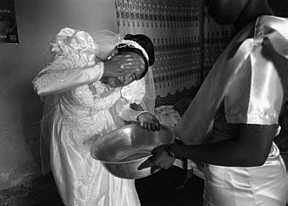
|
|
JUNE 2000 CONTENTS
|
|
RELATED SITES
|
|
AUTHOR'S NOTE
|
| Could winning equal rights on the battlefield earn Eritrean women more rights in civil society? Through her front-line photography, Pew Fellow Cheryl Hatch aimed to find out. |
A F F A I R S
The Struggle Continues
Photos by Cheryl Hatch

She returned to Eritrea last winter to find out, funded by a Pew
Fellowship from Hopkins's
Nitze School of Advanced
International Studies (SAIS). The newly launched program at
SAIS encourages working journalists to bring to light important
international stories that have received scant attention. What
Hatch found in Eritrea was "a report card both good and bad," she
says. After just several years of peace, war erupted again in
1998, in what has now become, she says, "the bloodiest conflict
on the planet, one that both sides say they don't want, and
neither side can explain." Hatch slept in refugee camps, holed
up in front-line bunkers, and conducted countless interviews to
capture the images you see here. Her findings: Eritrean women now
have representation in government and the right to own property.
And more young women are choosing the men they marry. But other
things haven't changed. Some 85 percent of women remain
illiterate, and 85 percent of girls, both Christian and Muslim,
are still being genitally mutilated.
--Sue De Pasquale

Beginning at 4 a.m. each morning, crowds of Eritrean women gather
at St. Mary's Church in Asmara to pray for peace (opening
photo).
These are the Eritrean mothers, deified in
their culture, who have offered their sons and daughters (like
the three female fighters at top) to the struggle; women comprise
nearly a third of the military.
Some women gather inside the church; others
fill the courtyard (below). Unclean women (those who are
menstruating, have recently given birth, or had sex the night
before) must remain outside the gate.

"Women now have the right to own property and you see fewer arranged marriages; but there's been little progress in terms of genital mutilation and illiteracy."

In the heat of the day, a lone fighter stands guard in an acacia
tree at Egri Mikhal (top). Beyond the front-line trench, the
Eritreans have heavily mined the stretch of land that separates
them from the Ethiopian soldiers.
Daily life continues in Asmara, where three
young girls jump rope (below), despite the ongoing threat of war
just 60 miles away from the capital city at the border with
Ethiopia.

 Genitally mutilated when she was a young girl,
16-year-old Gabriella Zerom (right) now works in a
government-sponsored campaign to educate others about associated
health risks; circumcision is practiced upon 85 percent of women
in Eritrea.
Genitally mutilated when she was a young girl,
16-year-old Gabriella Zerom (right) now works in a
government-sponsored campaign to educate others about associated
health risks; circumcision is practiced upon 85 percent of women
in Eritrea.
Villagers in Mai Aini raise baskets of teff
over their heads and
use the wind to sift the chaff (below). Teff is a staple food
source in Eritrea, used to make njera, a large pancake bread with
a slightly sour taste and doughy texture. Although Mai Aini is
just miles from the front line at Tserona, the villagers
continued the harvest.

"The fighting between Ethiopia and Eritrea is pretty much the bloodiest conflict on the planet and nobody's talking about it."

After her Sunday morning Orthodox wedding at St. Mary's church,
Freweine Asgedom, 26, returns home to freshen up (above). She and
her family will shortly host the groom's friends and family at a
lavish lunch, with dancing and drinking of mes, a honey wine.
Thousands of Eritrean women march along
Independence Avenue, demonstrating their desire for peace and an
end to the two-year conflict that has claimed 50,000 lives.


Waking from a late afternoon nap, an Eritrean soldier plays his
handmade kirar, a traditional musical instrument, in a bunker in
the front-line trench at Egri Mikhal (top).
The leg bones of an Ethiopian soldier protrude
from his boots along the Eritrean trenches at Egri Mikhal on the
border near Tserona.

RETURN TO JUNE 2000 TABLE OF CONTENTS.